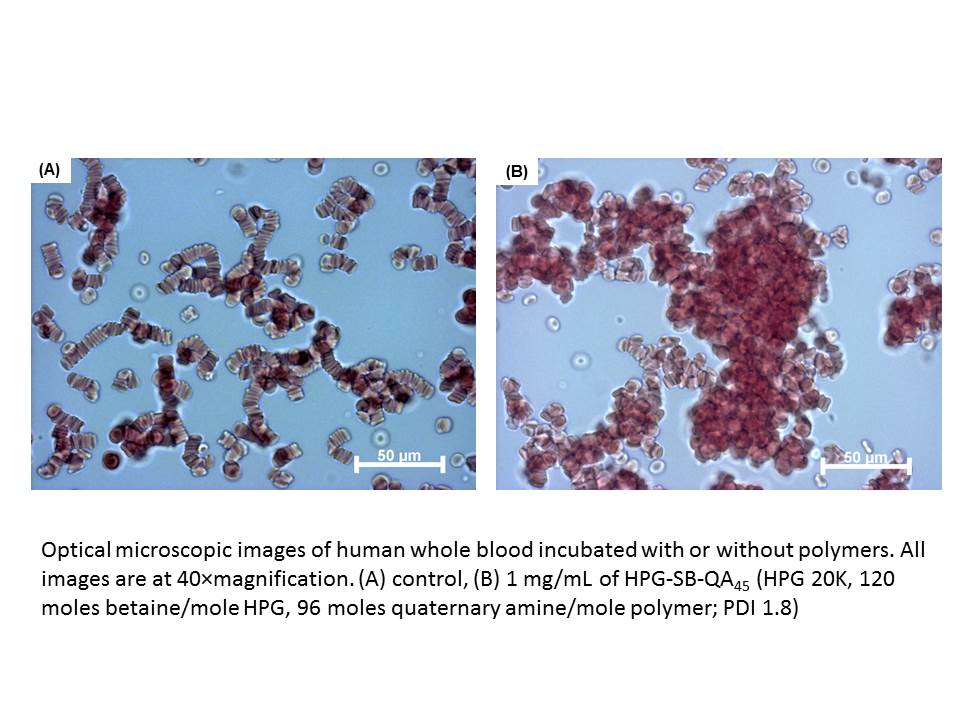Reversible hemostatic properties of sulfabetaine/quaternary ammonium modified hyperbranched polyglycerol
-
1
University of British Columbia, Department of Chemistry, Canada
-
2
University of British Columbia, Centre for Blood Research, Canada
-
3
Free University of Berlin, Institute for Chemistry and Biochemistry, Germany
-
4
University of British Columbia, Department of Pathology & Laboratory Medicine, Canada
Introduction: Enhancement of hemostasis at the site of a wound is an attractive method to limit bleeding and reduce the need for blood transfusion support. Cationic polymers aggressively bind to and aggregate a variety of biological cells because of their ability to interact strongly with negatively charged cell membranes but they have also been faced with the challenge of biocompatibility. Their relatively high cytotoxicity is related to disruption of the cell membrane which has limited their therapeutic applications. Therefore, methods to achieve defined and adjustable polymer/biomembrane interactions to control the strength of cell aggregation and enhance biocompatibility are highly desired.
Methods and Materials: A library of hyperbranched polyglycerols (HPGs) functionalized with different mole fractions of zwitterionic sulfabetaine and cationic quaternary ammonium ligands was synthesized and characterized. A post-polymerization method was employed that utilized double bond moieties on the HPG backbone for the coupling of functional groups via UV initiated thiol-ene “click” chemistry. The proportions of different ligands were precisely controlled by varying the monomer concentration during the irradiation process. The effect of the polymer library on hemostasis was investigated using whole or fractionated human blood.
Results and Discussion: It was found that polymer with ≥40% of alkenes converted to positive charges and the remainder to sulfabetaines caused hemagglutination at ≥1 mg/mL, without causing red blood cell lysis or cytotoxicity to cultured HUVEC. The quaternary ammonium groups can interact with the negatively charged sites on the cell membranes, providing bioadhesion. The zwitterionic sulfabetaines evidently provide a hydration layer to partially mask the adverse effects of cationic moieties. The polymer construct was also found able to enhance platelet aggregation and activation in a concentration and positive charge density-dependent manner, which would contribute to initiating hemostasis. Coagulation assays showed no effect of the constructs on extrinsic coagulation but intrinsic coagulation was inhibited somewhat when ≥30% of the alkenes were converted to quaternary amines and the remainder to sulfabetaines; similar effects were seen in thromboelastography studies on recalcified whole blood.

Conclusions: The dendritic sulfabetaine-protected polycations described here provide a new class of polymers capable of controlling hemostasis by a process independent of the normal blood clotting cascade but dependent on red blood cell agglutination, where the polymers provide blood immobility by linking erythrocytes together to form a lattice to entrap the cells. Further work will provide more information on their interactions with the coagulation system to optimize locally engendered clot formation.
Acknowledgements: This research was supported by a Natural Sciences & Engineering Research Council Canada Discovery Grant to DEB.
Keywords:
nanoparticle,
Polymeric material,
Novel material,
hemocompatiblility
Conference:
10th World Biomaterials Congress, Montréal, Canada, 17 May - 22 May, 2016.
Presentation Type:
New Frontier Oral
Topic:
Biomaterials in thrombosis and hemostasis
Citation:
Wen
J,
Weinhart
M,
Lai
B,
Kizhakkedathu
J and
Brooks
D
(2016). Reversible hemostatic properties of sulfabetaine/quaternary ammonium modified hyperbranched polyglycerol.
Front. Bioeng. Biotechnol.
Conference Abstract:
10th World Biomaterials Congress.
doi: 10.3389/conf.FBIOE.2016.01.00832
Copyright:
The abstracts in this collection have not been subject to any Frontiers peer review or checks, and are not endorsed by Frontiers.
They are made available through the Frontiers publishing platform as a service to conference organizers and presenters.
The copyright in the individual abstracts is owned by the author of each abstract or his/her employer unless otherwise stated.
Each abstract, as well as the collection of abstracts, are published under a Creative Commons CC-BY 4.0 (attribution) licence (https://creativecommons.org/licenses/by/4.0/) and may thus be reproduced, translated, adapted and be the subject of derivative works provided the authors and Frontiers are attributed.
For Frontiers’ terms and conditions please see https://www.frontiersin.org/legal/terms-and-conditions.
Received:
27 Mar 2016;
Published Online:
30 Mar 2016.